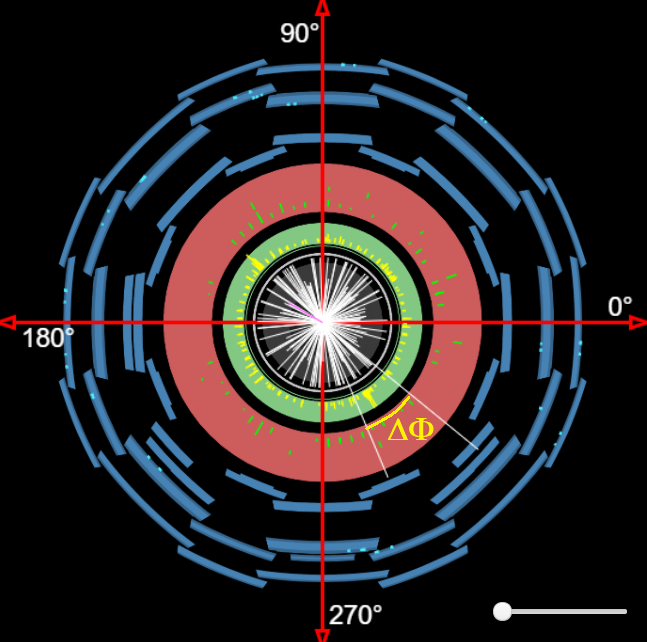W2D2 measurements: Discussion for Teachers
World Wide Data Day (W2D2) is a way for students to make reasonably simple, meaningful measurements from the ATLAS and CMS experiments of the Large Hadron Collider (LHC) at CERN.
What are the measurements?
Students select dimuon events from ATLAS or CMS data and focus on the direction angle Φ that each muon makes in the plane transverse to the beamline:

Transverse direction angles Φ1 and Φ2. In the 3-D view of a CMS dimuon event on the left, one can see two red tracks and red box-like objects. The red tracks are the reconstructed paths of muons coming from the center of the CMS detector, the shape of which is represented by the yellow wire-frame image. The orange tracks are low-energy background tracks. The boxes represent muon chambers that recorded the passage of the muons. The center image shows a side view, parallel to the LHC beamline, which is along the z-axis. The image to the right is the x-y view, transverse to the beamline. It is here that we measure the direction angles of the the muon tracks. Those angles, Φ1 and Φ2, are indicated in the image. Since the muon tracks are somewhat curved due to the magnetic field in CMS, we actually measure Φ from the x-axis to the tangent to the curve. Those tangent lines are shown in black here. In ATLAS, the central magnet is not as stong as in CMS and the tangent lines are not needed.
Opening angle ΔΦ - min value of |Φ1 - Φ2|. The opening angle is the minimum angle between the two muon tracks in the x-y or transverse plane. The image the the right shows the transverse plane for an ATLAS dimuon event. The many short white tracks which stay inside the green circle - the electromagenetic calorimeter - are background. (ATLAS event displays and CMS event displays have different color coding schemes!) The longer white tracks which go out well past the green electromagnetic calorimeter are muons. The angle between them, ΔΦ, is shon in yellow. Students should measure the smallest angle between the tracks. Here it is easy to see: ΔΦ measures out to about 28 degrees. The disallowed alternative to this is "the long way around" or 360o - 28o = 332o. ΔΦ should always be less than 180 degrees. Note also that for some events, the opening angle is actually quite large, close to 180 degrees.

Why these measurements?
As stated above, they are simple - easy to find and measure without a lot of detail work - and and they are meaningful.Together, they constitute a performance test of the ATLAS and CMS detectors. The Φ tmeasurement is to look for any preference in the direction of muons around the beampipe.
Questions to ask students about the Φ distribution:
- If the protons move along the beampipe and collide, is there any force that might push resulting particles in a particular direction perpendicular to that?
- Should we expect more muons at particular values of Φ or should the values of Φ be random?
- In that case, what should a distribution look like?
- How do you best account for variations from that expected distribution?
The results for ΔΦ are different. The opening angle of the two muons depends on the energies and momenta of the two muons. Both energy and momentum depend on the mass of the parent particle that was produced from the proton collision and then decayed into the muons. (Mass converts to energy, E=mc2!) The opening angle also depends on the initial energy and momentum of the parent particle away from and perpendicular to the beam pipe. The cartoon on the right breaks the process down.
Questions to ask students about the ΔΦ distribution:
- How does the mass of the parent particle affect the energies of the muons?
- How do the energies of the muons affect the opening angle?
- What size opening angle (large, small. does not matter) would you expect from muons that came from a parent particle with a small mass? High mass?
- What sort of distribution of ΔΦ would you expect if there is only one kind of particle decaying into two muons? More than one?

